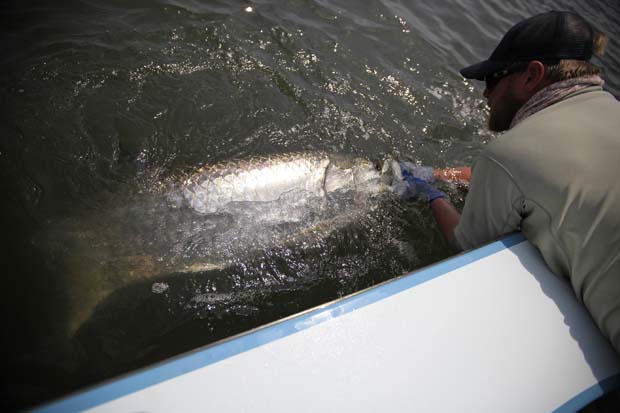While the following suggestions on landing, handling and releasing fish are written by the Florida Fish and Wildlife Conservation Commission (FWC) and Florida Sea Grant, they have a universal application. So whether you’re in Belize tarpon fishing, Texas bass fishing or in Alaska fishing for chinook salmon all of the advice is pertinent. Lets try for 100% survival of the fish not scheduled for the table!
A fish is too valuable to catch only once! Florida is the “Fishing Capital of the World,” largely because Florida carefully manages its valuable marine resources. We often are required to release saltwater fish when we catch them to help maintain fish populations, and more and more anglers are practicing “catch-and-release” to do their part to preserve marine fisheries while they enjoy their outdoor fishing experiences.
Handling Fish Properly
![Click here to [...]](https://flylifemagazine.com/wp-content/uploads/2013/04/coastal_king_july.jpg)
Here’s a fresh from the sea chinook salmon ready for a quick photo and release. Photo courtesy of The Royal Coachman Lodge. Visit Alaskan lodge
Handle fish as little as possible and only with wet hands – never with a towel. It’s best to take pictures of a fish being released while it is in the water.
If a net is needed to remove a fish from the water, use a knotless net.
It’s okay to take a picture of a fish if it needs to be briefly taken out of the water to measure it, vent it or remove the hook, but support the weight of the fish horizontally and safely return it to the water as quickly as possible – no lengthy “poses” just to take a picture.
If a fish must be lifted from the water, support its weight horizontally. Avoid lifting afish by its jaw, especially large fish. This can injure the fish so it can’t feed normally and/or harm its internal organs.
If a hook is deep in a fish’s throat or stomach, cut the line as close as possible to the hook – the hook will eventually dissolve inside the fish.
If a fish is exhausted, revive it before releasing it by passing water over its gills – move it forward in the water with its mouth open. Gently release a fish head first into the water.
Only gaff a fish when you’re sure it’s legal to harvest and you intend to keep it.
Never hold a fish by its gill cover.
Never put your hands or fingers in a fish’s gills or eyes.
Captain Ken Chambers De-hooking tools allow fishermen to easily and safely remove hooks while the fish remains in the water.
Ways to Help Fish Survive

Capt. Greg Dini gets photo – op and a quick release after a short fight by a knowledgeable angler. Click to visit Greg’s site.
Research has shown that you can significantly increase the survival rate of fish you catch with proper handling during the release.
Ethical anglers strive to save 100% of the fish they release.
Use tackle heavy enough to land a fish quickly to reduce exhaustion, which could result in its death or weaken it making it more vulnerable to predators.
Use non-stainless steel hooks – these hooks can dissolve if they remain in a fish.
Use non-offset circle hooks when fishing with natural bait to avoid gut-hooking a fish – circle hooks tend to hook fish in the jaw, making
them easy to remove.
Bend barbs down on hooks so they can be removed with less damage to a fish.
Use a venting tool if necessary to release pressure in a fish taken from deep water.
[information]Note: There are Special Requirements for Gulf of Mexico Reef Fish Anglers
Florida Fish and Wildlife Conservation Commission
620 South Meridian Street
Tallahassee, FL 32399-1600
(850) 488-6058
PO Box 110409
Gainesville, FL 32611-0409
(352) 392-1837

